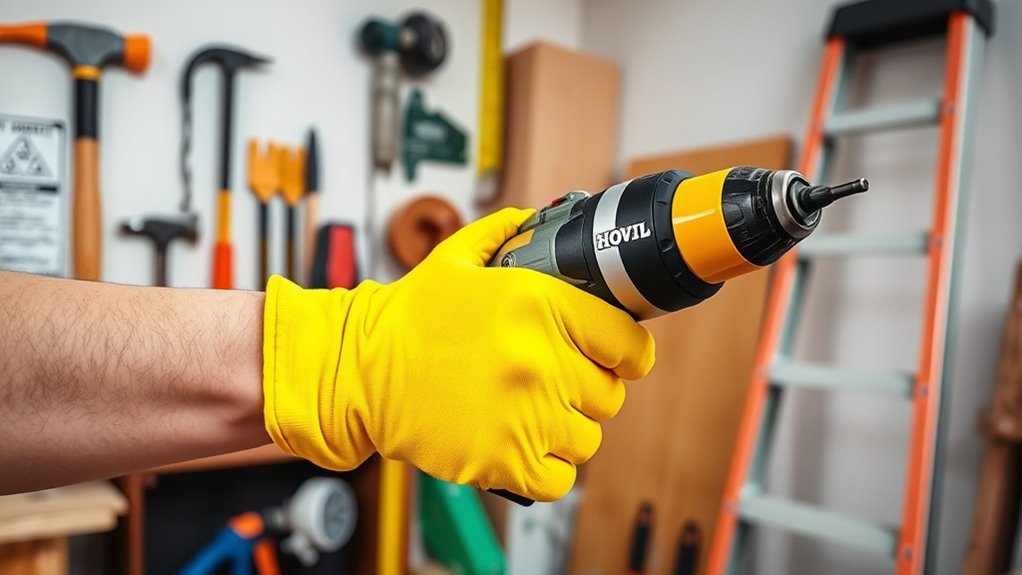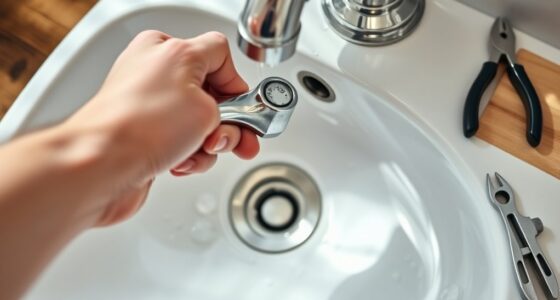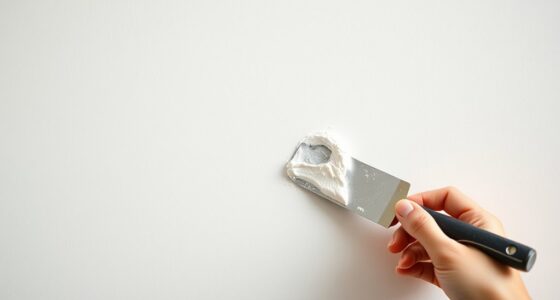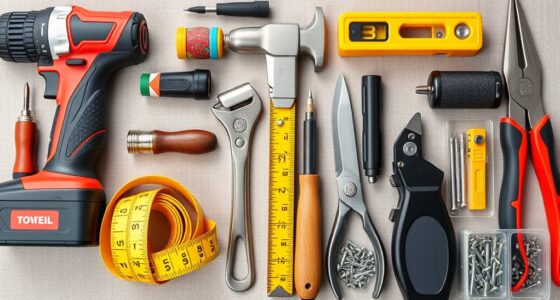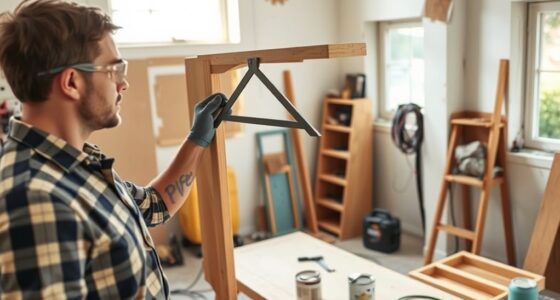To stay safe during your DIY home improvement projects, always wear appropriate PPE like goggles, gloves, and masks to protect yourself from debris and dust. Familiarize yourself with each tool’s safety features, inspect them regularly, and keep your workspace clean. Use ladders properly and avoid rushing through tasks to prevent accidents. Prioritizing safety helps prevent injuries, and if you look deeper, you’ll discover even more effective tips to work confidently and securely.
Key Takeaways
- Always wear appropriate PPE such as goggles, gloves, and dust masks to protect against debris and inhalation hazards.
- Familiarize yourself with each tool’s safety features and inspect for damage before use.
- Keep your workspace organized and clutter-free to prevent trips and accidents.
- Use ladders properly on stable surfaces and avoid overreaching when working at heights.
- Stay alert, follow manufacturer instructions, and prioritize safety over speed during all projects.
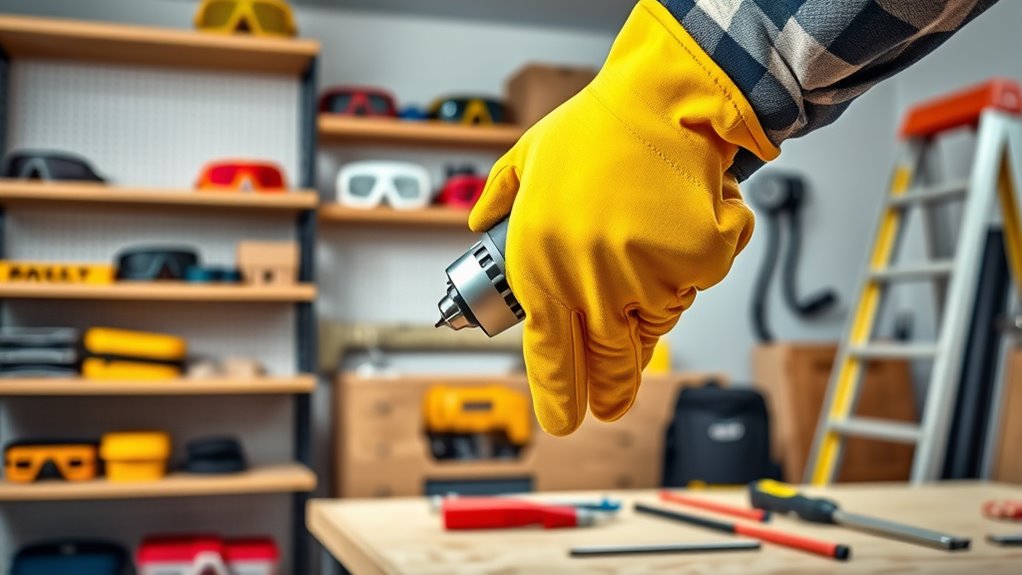
Starting on DIY home improvement projects can be rewarding, but safety should always come first. Before you grab your tools and immerse yourself in your project, it’s essential to prioritize your safety by using personal protective equipment (PPE). PPE acts as your first line of defense against potential injuries, whether it’s goggles to shield your eyes from flying debris, gloves to protect your hands from cuts and splinters, or ear protection when operating loud power tools. Investing in the right PPE and wearing it consistently ensures that minor accidents don’t turn into serious injuries. Remember, PPE isn’t optional—it’s a necessary part of working safely.
Prioritize safety with PPE—your first line of defense in DIY projects.
Equally important are tool safety guidelines that help prevent mishaps. Before you start, take a moment to familiarize yourself with each tool’s operation and safety features. Read the manufacturer’s instructions thoroughly, and never attempt to use a tool you’re unfamiliar with. Always inspect your tools before use; check for frayed cords, loose parts, or any signs of damage. Using damaged tools increases the risk of malfunction and injury. When handling power tools, ensure they’re turned off and unplugged when changing blades or bits, and keep your fingers away from cutting edges. Maintain a clean workspace, free of clutter and tripping hazards, to reduce accidents.
When cutting, drilling, or sanding, use PPE along with proper technique. For example, wearing a dust mask when sanding helps prevent inhaling harmful particles, and safety glasses protect your eyes from flying debris. Keep your hands steady and avoid rushing through tasks—speed often leads to mistakes and injuries. If a tool starts to vibrate or behave unexpectedly, turn it off immediately and inspect it before continuing. Proper handling and maintenance extend the lifespan of your tools and safeguard you from avoidable accidents.
Remember to always wear footwear with good grip and closed toes, especially when working on ladders or uneven surfaces. If you’re working at heights, use a sturdy ladder and ensure it’s on a stable surface. Never overreach or lean too far; instead, reposition your ladder or step stool. When in doubt, ask for help or consult online tutorials to confirm your technique. Staying alert and focused is key—don’t work when tired or distracted. Additionally, understanding projector technology can help you select the safest and most effective equipment for your specific home improvement needs.
Frequently Asked Questions
What Should I Do if I Get Injured During a Project?
If you get injured during a project, stop working immediately and assess the injury. Follow first aid steps like cleaning cuts, applying pressure to stop bleeding, or immobilizing the area if needed. To prevent further injury, seek medical attention if necessary. Always prioritize injury prevention by wearing proper safety gear and working carefully. Remember, taking quick, correct action helps minimize damage and guarantees your safety.
How Do I Choose the Right Protective Gear?
You might think protective gear is unnecessary, but a safety checklist shows it’s vital. To choose the right protective clothing, consider the specific task—eye protection for debris, gloves for handling sharp objects, and ear protection for loud noises. Always opt for gear that fits well and meets safety standards. Proper protective equipment keeps you safe and ensures your project goes smoothly, so invest wisely in quality gear.
Are There Safety Regulations for DIY Electrical Work?
You should know that electrical safety is critical when doing DIY electrical work. Regulations often require permit requirements to make sure your work meets safety standards. Always check local codes before starting, and if your project involves complex wiring or high voltage, consider consulting a professional. Following permit requirements and safety guidelines helps prevent accidents, electrical shocks, and fire hazards, keeping you safe while completing your project effectively.
How Can I Prevent Falls From Ladders?
Imagine you’re in the Renaissance, but you’re actually on a ladder today. To prevent falls, focus on ladder stability by placing it on a flat, level surface and securing it if needed. Always wear proper footwear with good grip to prevent slips. Keep three points of contact while climbing, and don’t overreach. These steps guarantee you stay safe and confident while working at height.
What Emergency Supplies Should I Have on Hand?
You should have essential emergency supplies on hand, like a well-stocked first aid kit to treat minor injuries quickly. Keep fire extinguishers accessible in case of fire hazards. Make sure everyone knows their locations and how to utilize them. Having these supplies ready ensures you’re prepared for accidents, helping you respond swiftly and safely during emergencies. Regularly check and maintain these supplies to keep them effective when needed.
Conclusion
Remember, safety should always be your top priority when tackling DIY projects. Think of it like wielding Excalibur—without care, you risk a mighty cut or mishap. Always wear your gear, follow instructions, and don’t rush. If something feels off, take a moment to reassess. By staying vigilant, you’ll avoid disasters and enjoy your handiwork. After all, a safe DIY adventure is a successful one—no need to be a knight in shining armor, just smart and cautious!
Alfons is the visionary leader and driving force behind Voyager Info’s success. As the Editor in Chief, he brings a wealth of experience and an unwavering passion for travel to the helm of our cruise-centric platform.
With a lifelong fascination for exploring new horizons, Alfons discovered his love for the ocean and cruising at a young age. From sailing across pristine Caribbean waters to embarking on daring expeditions to far-flung destinations, he has amassed a treasure trove of first-hand experiences in the world of cruising.

